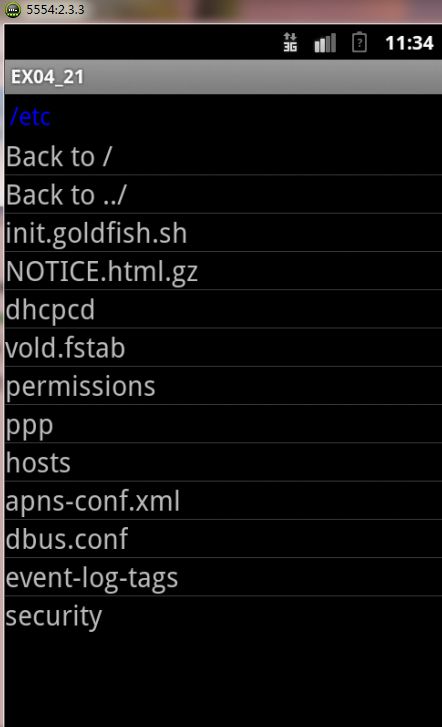Android--查找程序根目录下所有文件/Java IO操作
本实例实现的是浏览根目录下所有的文件,包含子目录下所有的文件,类似于实现“Windows资源管理器”,首先,先看下程序的实现截图:
这个程序应用的是ListActivity和JavaIO的知识。
首先,让我们先看下主程序的布局文件定义:
<?xml version="1.0" encoding="utf-8"?>
<LinearLayout xmlns:android="http://schemas.android.com/apk/res/android"
android:layout_width="wrap_content"
android:layout_height="wrap_content"
android:orientation="vertical"
>
<TextView
android:id="@+id/mPath"
android:layout_width="wrap_content"
android:layout_height="wrap_content"
android:padding="5px"
android:textSize="18sp"
android:textColor="@drawable/blue"
/>
<ListView
android:id="@android:id/list"
android:layout_width="wrap_content"
android:layout_height="wrap_content"
/>
</LinearLayout>
其中,ListView中的各个子TextView也是由程序提供,布局文件如下:
<?xml version="1.0" encoding="utf-8"?> <TextView android:id="@+id/text1" xmlns:android="http://schemas.android.com/apk/res/android" android:layout_width="wrap_content" android:layout_height="wrap_content" android:textSize="20sp" />
主程序的实现代码如下:
public class EX04_21 extends ListActivity
{
/* 对象声明
items:存放显示的名称
paths:存放文件路径
rootPath:起始目录
*/
private List<String> items=null;
private List<String> paths=null;
private String rootPath="/";
private TextView mPath;
/** Called when the activity is first created. */
@Override
protected void onCreate(Bundle icicle)
{
super.onCreate(icicle);
/* 加载main.xml Layout */
setContentView(R.layout.main);
mPath=(TextView)findViewById(R.id.mPath);
getFileDir(rootPath);
}
/* 取得文件架构的method */
private void getFileDir(String filePath)
{
/* 设定目前所在路径 */
mPath.setText(filePath);
items=new ArrayList<String>();
paths=new ArrayList<String>();
File f=new File(filePath);
File[] files=f.listFiles();
if(!filePath.equals(rootPath))
{
/* 第一笔设定为[回到根目录] */
items.add("Back to "+rootPath);
paths.add(rootPath);
/* 第二笔设定为[回上层] */
items.add("Back to ../");
paths.add(f.getParent());
}
/* 将所有文件加入ArrayList中 */
for(int i=0;i<files.length;i++)
{
File file=files[i];
items.add(file.getName());
paths.add(file.getPath());
}
/* 声明一ArrayAdapter,使用file_row这个Layout,
并将Adapter设定给此ListActivity */
ArrayAdapter<String> fileList =
new ArrayAdapter<String>(this,R.layout.file_row, items);
setListAdapter(fileList);
}
/* 设定ListItem被按下时要做的动作 */
@Override
protected void onListItemClick(ListView l,View v,int position,long id)
{
File file = new File(paths.get(position));
if(file.canRead())
{
if (file.isDirectory())
{
/* 如果是文件夹就再进去读取 */
getFileDir(paths.get(position));
}
else
{
/* 如果是文件,则弹出AlertDialog */
new AlertDialog.Builder(this)
.setTitle("Message")
.setMessage("["+file.getName()+"] is File!")
.setPositiveButton("OK",
new DialogInterface.OnClickListener()
{
public void onClick(DialogInterface dialog,int which)
{
}
}).show();
}
}
else
{
/* 弹出AlertDialog显示权限不足 */
new AlertDialog.Builder(this)
.setTitle("Message")
.setMessage("权限不足!")
.setPositiveButton("OK",
new DialogInterface.OnClickListener()
{
public void onClick(DialogInterface dialog,int which)
{
}
}).show();
}
}
}
